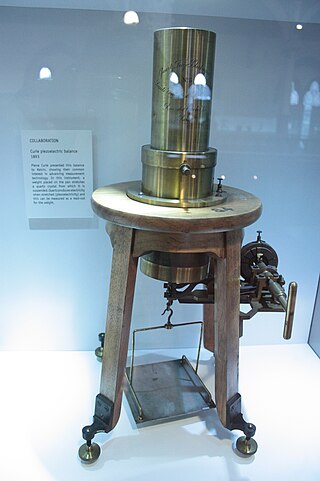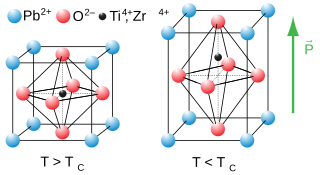Related Research Articles

Piezoelectricity is the electric charge that accumulates in certain solid materials—such as crystals, certain ceramics, and biological matter such as bone, DNA, and various proteins—in response to applied mechanical stress. The word piezoelectricity means electricity resulting from pressure and latent heat. It is derived from Ancient Greek πιέζω (piézō) 'to squeeze or press', and ἤλεκτρον (ḗlektron) 'amber'. The German form of the word (Piezoelektricität) was coined in 1881 by the German physicist Wilhelm Gottlieb Hankel; the English word was coined in 1883.
Ferroelectricity is a characteristic of certain materials that have a spontaneous electric polarization that can be reversed by the application of an external electric field. All ferroelectrics are also piezoelectric and pyroelectric, with the additional property that their natural electrical polarization is reversible. The term is used in analogy to ferromagnetism, in which a material exhibits a permanent magnetic moment. Ferromagnetism was already known when ferroelectricity was discovered in 1920 in Rochelle salt by Joseph Valasek. Thus, the prefix ferro, meaning iron, was used to describe the property despite the fact that most ferroelectric materials do not contain iron. Materials that are both ferroelectric and ferromagnetic are known as multiferroics.

Pyroelectricity is a property of certain crystals which are naturally electrically polarized and as a result contain large electric fields. Pyroelectricity can be described as the ability of certain materials to generate a temporary voltage when they are heated or cooled. The change in temperature modifies the positions of the atoms slightly within the crystal structure, so that the polarization of the material changes. This polarization change gives rise to a voltage across the crystal. If the temperature stays constant at its new value, the pyroelectric voltage gradually disappears due to leakage current. The leakage can be due to electrons moving through the crystal, ions moving through the air, or current leaking through a voltmeter attached across the crystal.

Polyvinylidene fluoride or polyvinylidene difluoride (PVDF) is a highly non-reactive thermoplastic fluoropolymer produced by the polymerization of vinylidene difluoride. Its chemical formula is (C2H2F2)n.

Lead zirconate titanate, also called lead zirconium titanate and commonly abbreviated as PZT, is an inorganic compound with the chemical formula Pb[ZrxTi1−x]O3(0 ≤ x ≤ 1). It is a ceramic perovskite material that shows a marked piezoelectric effect, meaning that the compound changes shape when an electric field is applied. It is used in a number of practical applications such as ultrasonic transducers and piezoelectric resonators. It is a white to off-white solid.
In electromagnetism, electrostriction is a property of all electrical non-conductors, or dielectrics, that causes them to change their shape under the application of an electric field. It is the dual property to magnetostriction.

Lithium tantalate is the inorganic compound with the formula LiTaO3. It is a white, diamagnetic, water-insoluble salt. The compound has the perovskite structure. It has optical, piezoelectric, and pyroelectric properties that make it valuable for nonlinear optics, passive infrared sensors such as motion detectors, terahertz generation and detection, surface acoustic wave applications, cell phones. Considerable information is available from commercial sources about this material.
Electroceramics are a class of ceramic materials used primarily for their electrical properties.

Barium titanate (BTO) is an inorganic compound with chemical formula BaTiO3. Barium titanate appears white as a powder and is transparent when prepared as large crystals. It is a ferroelectric, pyroelectric, and piezoelectric ceramic material that exhibits the photorefractive effect. It is used in capacitors, electromechanical transducers and nonlinear optics.

Lithium niobate is a synthetic salt consisting of niobium, lithium, and oxygen. Its single crystals are an important material for optical waveguides, mobile phones, piezoelectric sensors, optical modulators and various other linear and non-linear optical applications. Lithium niobate is sometimes referred to by the brand name linobate.
Lead scandium tantalate (PST) is a mixed oxide of lead, scandium, and tantalum. It has the formula Pb(Sc0.5Ta0.5)O3. It is a ceramic material with a perovskite structure, where the Sc and Ta atoms at the B site have an arrangement that is intermediate between ordered and disordered configurations, and can be fine-tuned with thermal treatment. It is ferroelectric at temperatures below 270 K (−3 °C; 26 °F), and is also piezoelectric. Like structurally similar lead zirconate titanate and barium strontium titanate, PST can be used for manufacture of uncooled focal plane array infrared imaging sensors for thermal cameras.
The Burns temperature, Td, is the temperature where a ferroelectric material, previously in paraelectric state, starts to present randomly polarized nanoregions, that are polar precursor clusters. This behaviour is typical of several, but not all, ferroelectric materials, and was observed in lead titanate (PbTiO3), potassium niobate (KNbO3), lead lanthanum zirconate titanate (PLZT), lead magnesium niobate (PMN), lead zinc niobate (PZN), K2Sr4(NbO3)10, and strontium barium niobate (SBN), Na1/2Bi1/2O3 (NBT).

Ferroelectric polymers are a group of crystalline polar polymers that are also ferroelectric, meaning that they maintain a permanent electric polarization that can be reversed, or switched, in an external electric field.

Strontium barium niobate is the chemical compound SrxBa1−xNb2O6 for 0.32≤x≤0.82.
Relaxor ferroelectrics are ferroelectric materials that exhibit high electrostriction. As of 2015, although they have been studied for over fifty years, the mechanism for this effect is still not completely understood, and is the subject of continuing research.
Sodium bismuth titanate or bismuth sodium titanium oxide (NBT or BNT) is a solid inorganic compound of sodium, bismuth, titanium and oxygen with the chemical formula of Na0.5Bi0.5TiO3 or Bi0.5Na0.5TiO3. This compound adopts the perovskite structure.

Kenji Uchino is an American electronics engineer, physicist, academic, inventor and industry executive. He is currently a professor of Electrical Engineering at Pennsylvania State University, where he also directs the International Center for Actuators and Transducers at Materials Research Institute. He is the former associate director at The US Office of Naval Research – Global Tokyo Office.

Dragan Damjanovic is a Swiss-Bosnian-Herzegovinian materials scientist. From 2008 to 2022, he was a professor of material sciences at EPFL and head of the Group for Ferroelectrics and Functional Oxides.
Nickel niobate is a complex oxide which as a solid material has found potential applications in catalysis and lithium batteries.
References
- ↑ Bokov, A. A.; Ye, Z. -G. (2006). "Recent progress in relaxor ferroelectrics with perovskite structure". Journal of Materials Science. 41 (1): 31–52. Bibcode:2006JMatS..41...31B. doi:10.1007/s10853-005-5915-7. S2CID 189842194.
- ↑ Shipman, Matt (20 February 2018). "Atomic Structure of Ultrasound Material Not What Anyone Expected". NC State News.
- ↑ Cabral, Matthew J.; Zhang, Shujun; Dickey, Elizabeth C.; LeBeau, James M. (19 February 2018). "Gradient chemical order in the relaxor Pb(MgNb)O". Applied Physics Letters. 112 (8): 082901. Bibcode:2018ApPhL.112h2901C. doi:10.1063/1.5016561.
- ↑ Capobianco, Joseph; Shih, Wei-Heng; Leu, Jiann-Horng; Lo, Grace Chu-Fang; Shih, Wan Y. (15 November 2010). "Label Free Detection of White Spot Syndrome Virus Using Lead Magnesium Niobate-Lead Titanate Piezoelectric Microcantilever Sensors". Biosensors & Bioelectronics. 26 (3): 964–969. doi:10.1016/j.bios.2010.08.004. ISSN 0956-5663. PMC 3412145 . PMID 20863681.